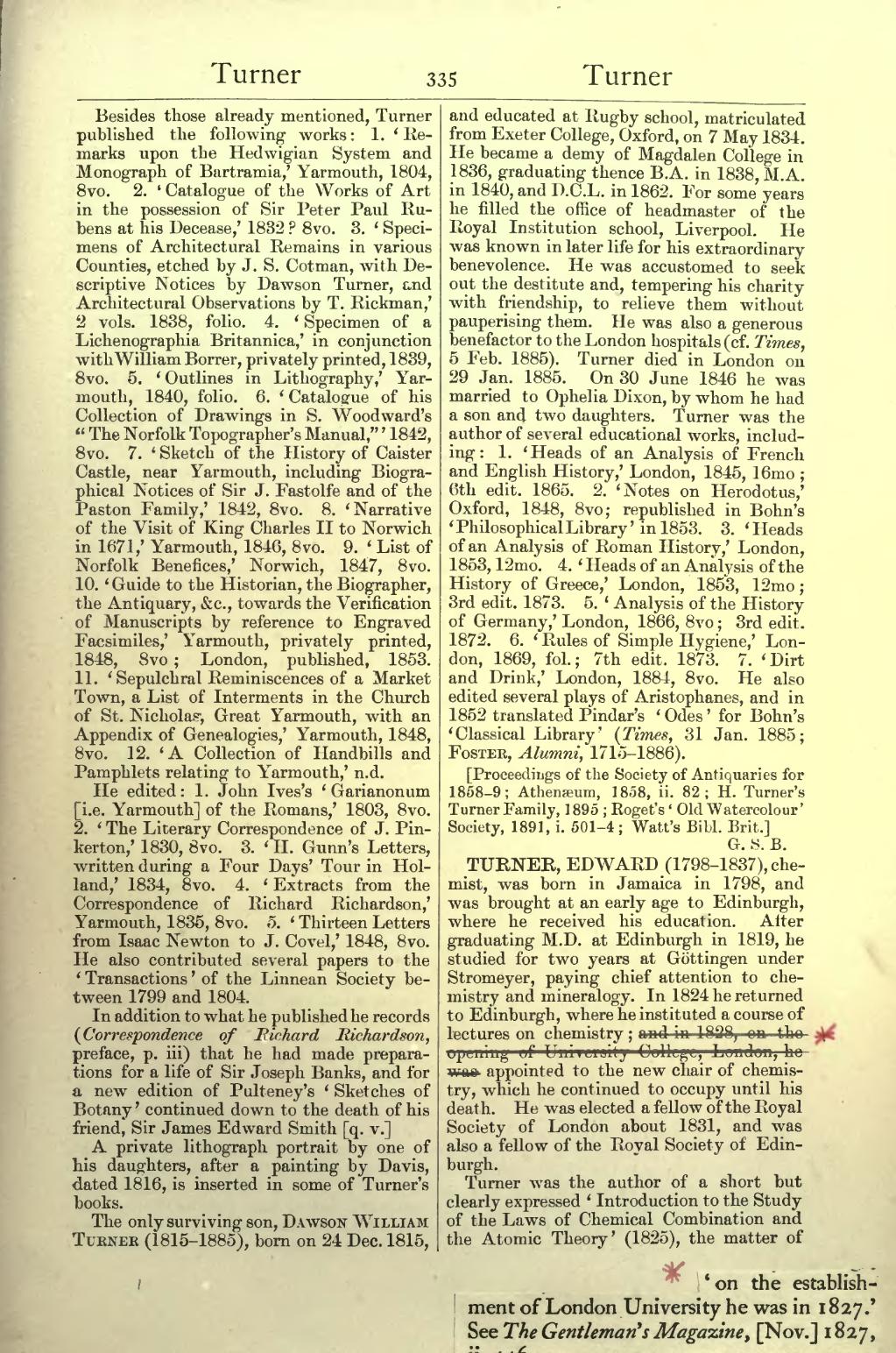Besides those already mentioned, Turner published the following works: 1. ‘Remarks upon the Hedwigian System and Monograph of Bartramia,’ Yarmouth, 1804, 8vo. 2. ‘Catalogue of the Works of Art in the possession of Sir Peter Paul Rubens at his Decease,’ 1832? 8vo. 3. ‘Specimens of Architectural Remains in various Counties, etched by J. S. Cotman, with Descriptive Notices by Dawson Turner, and Architectural Observations by T. Rickman,’ 2 vols. 1838, folio. 4. ‘Specimen of a Lichenographia Britannica,’ in conjunction with William Borrer, privately printed, 1839, 8vo. 5. ‘Outlines in Lithography,’ Yarmouth, 1840, folio. 6. ‘Catalogue of his Collection of Drawings in S. Woodward's “The Norfolk Topographer's Manual,”’ 1842, 8vo. 7. ‘Sketch of the History of Caister Castle, near Yarmouth, including Biographical Notices of Sir J. Fastolfe and of the Paston Family,’ 1842, 8vo. 8. ‘Narrative of the Visit of King Charles II to Norwich in 1671,’ Yarmouth, 1846, 8vo. 9. ‘List of Norfolk Benefices,’ Norwich, 1847, 8vo. 10. ‘Guide to the Historian, the Biographer, the Antiquary, &c., towards the Verification of Manuscripts by reference to Engraved Facsimiles,’ Yarmouth, privately printed, 1848, 8vo; London, published, 1853. 11. ‘Sepulchral Reminiscences of a Market Town, a List of Interments in the Church of St. Nicholas, Great Yarmouth, with an Appendix of Genealogies,’ Yarmouth, 1848, 8vo. 12. ‘A Collection of Handbills and Pamphlets relating to Yarmouth,’ n.d.
He edited: 1. John Ives's ‘Garianonum [i.e. Yarmouth] of the Romans,’ 1803, 8vo. 2. ‘The Literary Correspondence of J. Pinkerton,’ 1830, 8vo. 3. ‘H. Gunn's Letters, written during a Four Days' Tour in Holland,’ 1834, 8vo. 4. ‘Extracts from the Correspondence of Richard Richardson,’ Yarmouth, 1835, 8vo. 5. ‘Thirteen Letters from Isaac Newton to J. Covel,’ 1848, 8vo. He also contributed several papers to the ‘Transactions’ of the Linnean Society between 1799 and 1804.
In addition to what he published he records (Correspondence of Richard Richardson, preface, p. iii) that he had made preparations for a life of Sir Joseph Banks, and for a new edition of Pulteney's ‘Sketches of Botany’ continued down to the death of his friend, Sir James Edward Smith [q. v.]
A private lithograph portrait by one of his daughters, after a painting by Davis, dated 1816, is inserted in some of Turner's books.
The only surviving son, Dawson William Turner (1815–1885), born on 24 Dec. 1815, and educated at Rugby school, matriculated from Exeter College, Oxford, on 7 May 1834. He became a demy of Magdalen College in 1836, graduating thence B.A. in 1838, M.A. in 1840, and D.C.L. in 1862. For some years he filled the office of headmaster of the Royal Institution school, Liverpool. He was known in later life for his extraordinary benevolence. He was accustomed to seek out the destitute and, tempering his charity with friendship, to relieve them without pauperising them. He was also a generous benefactor to the London hospitals (cf. Times, 5 Feb. 1885). Turner died in London on 29 Jan. 1885. On 30 June 1846 he was married to Ophelia Dixon, by whom he had a son and two daughters. Turner was the author of several educational works, including: 1. ‘Heads of an Analysis of French and English History,’ London, 1845, 16mo; 6th edit. 1865. 2. ‘Notes on Herodotus,’ Oxford, 1848, 8vo; republished in Bohn's ‘Philosophical Library’ in 1853. 3. ‘Heads of an Analysis of Roman History,’ London, 1853, 12mo. 4. ‘Heads of an Analysis of the History of Greece,’ London, 1853, 12mo; 3rd edit. 1873. 5. ‘Analysis of the History of Germany,’ London, 1866, 8vo; 3rd edit. 1872. 6. ‘Rules of Simple Hygiene,’ London, 1869, fol.; 7th edit. 1873. 7. ‘Dirt and Drink,’ London, 1884, 8vo. He also edited several plays of Aristophanes, and in 1852 translated Pindar's ‘Odes’ for Bohn's ‘Classical Library’ (Times, 31 Jan. 1885; Foster, Alumni, 1715–1886).
[Proceedings of the Society of Antiquaries for 1858–9; Athenæum, 1858, ii. 82; H. Turner's Turner Family, 1895; Roget's ‘Old Watercolour’ Society, 1891, i. 501–4; Watt's Bibl. Brit.]
TURNER, EDWARD (1798–1837), chemist, was born in Jamaica in 1798, and was brought at an early age to Edinburgh, where he received his education. After graduating M.D. at Edinburgh in 1819, he studied for two years at Göttingen under Stromeyer, paying chief attention to chemistry and mineralogy. In 1824 he returned to Edinburgh, where he instituted a course of lectures on chemistry; and in 1828, on the opening of University College, London, he was appointed to the new chair of chemistry, which he continued to occupy until his death. He was elected a fellow of the Royal Society of London about 1831, and was also a fellow of the Royal Society of Edinburgh.
Turner was the author of a short but clearly expressed ‘Introduction to the Study of the Laws of Chemical Combination and the Atomic Theory’ (1825), the matter of
